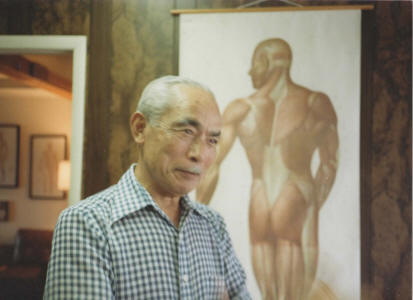Hoshino Therapy®
 Professor Tomezo Hoshino
Professor Tomezo Hoshino
Tomezo Hoshino was born in Atsugui, Japan, in 1910 to a long line of acupuncturists, and it was assumed he would follow in the family tradition. As fate would have it, when he was 16 years old he was injured in a motorcycle accident and lost his eyesight. In need of a vocation, he studied Hama massage, which is specifically for blind practitioners. After 18 months, he had another blow to his head, and his sight was restored. At that point, he did not want to work as an Hama masseur any longer, but rather wanted to see the world. He traveled first to Argentina, where he worked as a gaucho, but after some time, because he was suffering from a neuralgia resulting from his original injury, he returned to Japan for acupuncture treatments. The acupuncturist who treated him noticed his hands, and asked him if he was a musician, saying that he had very special hands. Hoshino always remembered this, but did not want to be known as an Hama massage practitioner. He entered the Tokyo School of Acupuncture and graduated in 1939.
Afterwards, Hoshino returned to Argentina and, because at that time acupuncture was not recognized as a legitimate profession there, he found work as a massage therapist at an institute for pedicurists. Here he began to use the great sensitivity in his hands that he had developed during his blindness. Because of his massage, many of the customers were not developing callouses as they had been, and so they did not need to return for their regular pedicures. This was noticed by the director of the institute, and Hoshino was subsequently fired from his position. Hoshino started his own practice and successfully treated several of the Buenos Aires elite and also a polo player, Michael Phipps, from Florida. Phipps had been crippled with arthritis and when he walked he was “bent like a crab” according to Hoshino. Fourteen months later he was pain-free, walked normally, and actually won an important golf tournament. He was so grateful to Hoshino that he donated $1 million toward the establishment of an institute in Florida where students could learn the Hoshino technique. Before this institute was started, Hoshino had programs under the auspices of Florida Atlantic University, in Boca Raton, as well as Doctors Hospital in Plantation, Florida where he successfully treated hundreds of cases which were fully documented. In 1969 Hoshino opened the Institute for the Treatment of Arthritis and Allied Disorders in Deerfield Beach, Florida, where he spent six months each year teaching his art and treating hundreds of cases of arthrosis (see below). In 1973, Phipps died and the institute was closed, so Hoshino and two students whom he trained opened a clinic in Boca Raton and later another clinic in Coconut Grove. Hoshino continued to divide his time equally between the U.S. and Argentina and in 1986, his therapy was officially recognized as a approved profession by the Argentina Association of Kinesiology. Starting that same year, his course was taught as a post-graduate specialty at the Academy of Kinesiology and Physiatry in Buenos Aires.
Hoshino retired from full-time teaching in the early 1990’s and died in 2000 in Argentina.
Famous people treated by Hoshino:
Arthur Rubenstein, Maurice Chevalier, Gary Cooper, Tyrone Power, Marlene Dietrich, Princess Joan of Luxemburg, Cesar Chavez, the Duke and Duchess of Windsor, and Prince Phillip, the son of the king of Spain
What Is Arthrosis?
Arthrosis is the term used in Hoshino Therapy to describe the disorder commonly referred to as arthritis or osteo-arthritis. It has plagued mankind throughout history and today ranks among the most important medical problems of the civilized world. While the terms arthritis or osteo-arthritis refer to bone disorders, arthrosis is a broad term referring to disorders resulting from the hardening of skeletal-related soft tissues, i.e. muscles, tendons and ligaments. It includes impairments such as bursitis, tendonitis, sciatica, migraine headaches, non-traumatic back problems (meaning not caused by direct trauma to the spine), and joint problems such as limited finger mobility which are not complicated by systemic disease.
